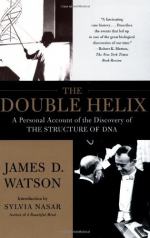
|
| Name: _________________________ | Period: ___________________ |
This test consists of 15 multiple choice questions and 5 short answer questions.
Multiple Choice Questions
1. What did Bragg finally allow Watson to do?
(a) Invite Maurice to join Watson on the project
(b) Allow him to work with Pauling to refine his model
(c) Move to a new lab where he will continue his work on RNA
(d) Start working on DNA again
2. What was Watson continually thinking about as he went to films in regards to progress on DNA model?
(a) Bases
(b) Number of chains
(c) Building materials
(d) Acids
3. How much progress did Crick make?
(a) A lot
(b) A little
(c) None
(d) Significant
4. How old was Rosy when she died?
(a) 37
(b) 60
(c) 25
(d) 54
5. What was wrong with Maurice at the meeting in Paris?
(a) He had eaten bad food
(b) He was tired of talking about DNA
(c) He was tired of Watson and Crick
(d) He wanted to be on his way to Brazil
6. Who confirmed Watson's finding that TMV was indeed a helix?
(a) Rosy
(b) Pauling
(c) Maurice
(d) Crick
7. Which of the following best describes how Watson felt upon realizing that Pauling's model was flawed?
(a) Relieved
(b) Enthusiastic
(c) Dejected
(d) Surprised
8. How did Maurice answer when asked if he minded Watson and Crick working on the structure of DNA?
(a) No, immediately
(b) Yes, immediately
(c) He said they should all work together
(d) No, but slowly
9. What did Watson continue to believe the problem was?
(a) Bases
(b) Chain number
(c) Acid level
(d) Backbone
10. What shape was Watson trying to prove TMV was?
(a) Cylindrical
(b) Hexical
(c) Octagonal
(d) Helical
11. The epilogue can best be described as which of the following?
(a) A celebration of their winning the Nobel Prize
(b) An apology for how Rosy was perceived throughout his career
(c) A short chapter reaffirming the importance of their work
(d) A summary of the book
12. How did Maurice respond to all of the arguments that went into constructing the DNA model?
(a) Criticized
(b) Debated
(c) Refuted
(d) Accepted
13. Who has developed a structure of DNA in chapter twenty-one?
(a) Rosy
(b) Linus Pauling
(c) Watson
(d) Crick
14. What did Watson and Crick do when the bases were finished?
(a) Studied more books and information
(b) Told King's lab
(c) Took an exended break
(d) Constructed a model
15. What medical condition did Watson seem to think he had?
(a) Ulcer
(b) Migraines
(c) Heart condition
(d) Reflux
Short Answer Questions
1. What did Watson diverge from his study of DNA to study?
2. Which of the following characteristics best describes how Watson viewed the conference in London?
3. Where had Watson moved?
4. What does Watson hope to learn more about as he studies TMV?
5. Who was taken with Watson's sister?
|
This section contains 422 words (approx. 2 pages at 300 words per page) |

|




